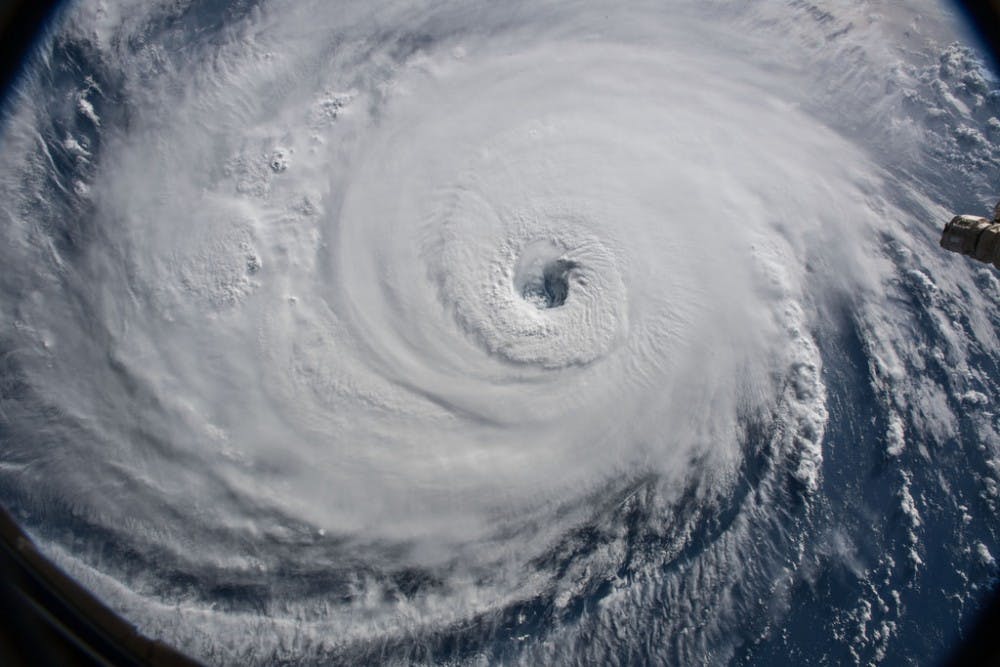It was only a few days ago when students were looking out the window to blue skies, dreaming of a beautiful weekend and only worrying about that problem set due Friday.
How did we end up here?
Out in the ocean
The key ingredients to stirring up a hurricane are a tropical system at at least 80 degrees Fahrenheit, a moist atmosphere, a warm ocean surface and some vertical windshear.
Because of these required conditions, hurricanes mostly form between 5 and 15 degrees north and south of the equator said Wenhong Li, associate professor of climate.
“There are several factors that could influence hurricane genesis and intensity,” Li said. “Warmer oceans provide fuel for hurricanes. We thus will likely observe much stronger hurricanes—which leads to more damage if they make landfall—in a warming climate.”
Hitting land
The increased friction and decreased moisture of land slows down the hurricane’s momentum, and the first to get hit in North Carolina will be the barrier islands.
Stuart Pimm, Doris Duke professor of conservation ecology, said that Florence has the capacity to completely rearrange the Barrier Islands by moving or destroying the islands. By next week, it will look like winter with all the vegetation blown off, he added.
“What I hope most of all is that this storm does not become an urban renewal thing like so many other storms,” Orrin Pilkey, James B. Duke professor emeritus of geology said. “We first learned about this with Hurricane Hugo... what happened was a lot of the mom-and-pop beach cottages were demolished and replaced by McMansions—three-story rental buildings that are so common now on North Carolina and South Carolina shores.”
Martin Doyle, professor in the environmental sciences and policy division, criticized the traditional government response to this type of disaster.
He pointed out that if a storm has a large impact, it will be called "an act of God" and something that "we couldn't do anything about."
“After a disaster, the government will basically give money to rebuild in the same place,” Doyle said. “What’s the definition of insanity? Doing the same thing over again and expecting a different outcome? Our responses to disasters are largely insane.”
Doyle questioned whether rebuilding was the right strategy for his hometown of New Orleans.
“With major towns all near rivers and coasts, these are societally changing decisions,” Doyle said. “As sea levels rise, of course it’s going to get worse.”
Moving inland
Pimm also pointed toward Hurricane Hugo—a 1989 hurricane that hit shore just north of Charleston, causing 27 deaths in South Carolina and costing the United States $7 billion dollars—to predict the aftermath of Florence.
“The pine trees flattened by Hugo took decades to grow back,” Pimm said. “This is a huge risk to the red-cockaded woodpecker that depends on pine.”
Braced for the destruction that’ll be caused by trees, Duke Energy already has thousands of power line trucks sitting at the edge of the storm line, Doyle said.
Florence in Durham
Get The Chronicle straight to your inbox
Sign up for our weekly newsletter. Cancel at any time.
Although the hurricane will hurt birds like woodpeckers, the hurricane’s large floods will actually help fish—especially long-lived fish such as sturgeon—giving the cue for the fish to spawn.
The fish in the rivers have evolved for flooding, and in many ways, so has Durham. Doyle said that all the rivers around Durham have U.S. Army Corps of Engineers flood control dams.
David Schaad, professor of the practice of civil and environmental engineering, said that Durham’s water system is manned 24/7 with backup generators and has a three day supply of water to prevent water contamination in residents’ water supplies.
Durham is also elevated at 400 feet above sea level and has some hills.
Water will drain into Jordan Lake on the Cape Fear River and Falls Lake on the Neuse River—all downstream of Durham. West Campus will drain south into Mud Creek and East Campus will drain north toward Ellerbe Creek.
The professors see the looming storm as a potential learning experience.
“When there is a big event like a flood, we get to watch geologic-scale processes happen,” Doyle said.
After Florence dissipates
The Carolinas recovered from Hurricane Hugo and will recover from Florence too, Pimm said. But what makes Florence different from Hugo is one worsening condition—global warming.
“We can’t attribute any particular storm to global warming, but we do know the oceans are warming up and warm water feeds and drives hurricanes,” Pimm said. “We have politicians in the Carolinas who refuse to believe in global warming. [Hurricane Florence] is one of those events that will make them look as stupid as they really are.”
Correction: This article was updated to reflect that Hugo struck just north of Charleston. The Chronicle regrets the error.

